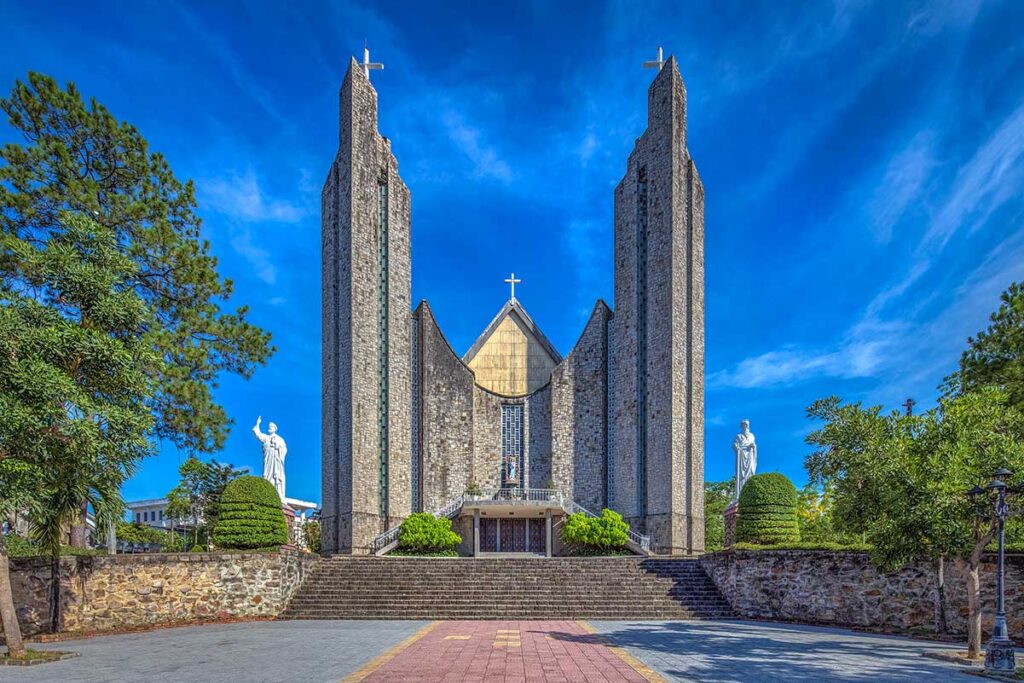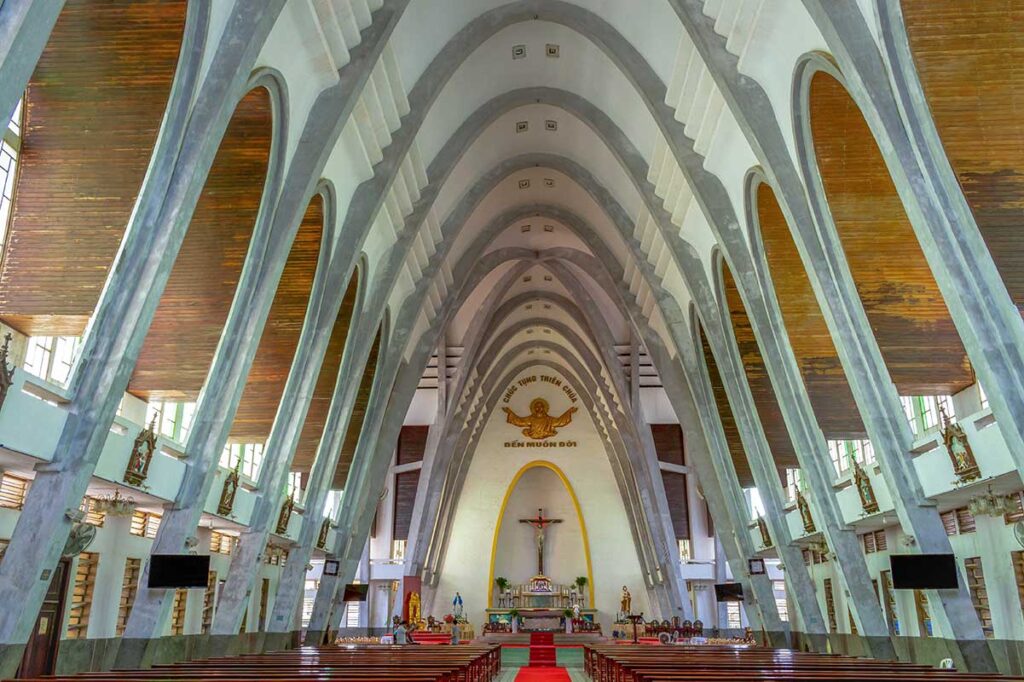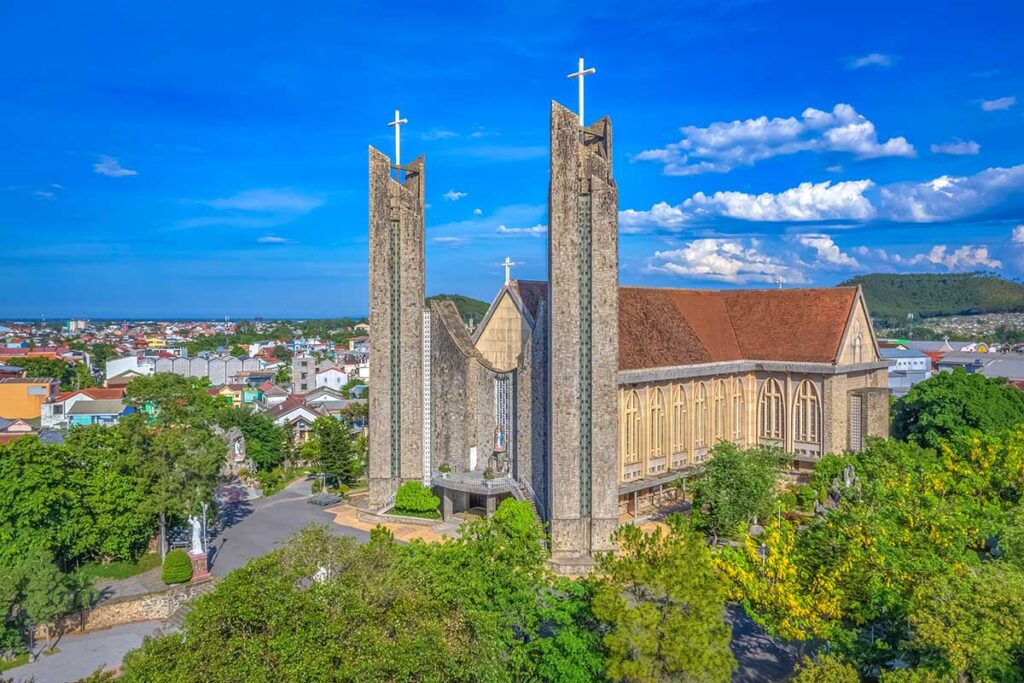History and background of Phu Cam Cathedral
Phu Cam Cathedral traces its origins back to the 17th century, when it was first built to serve a growing community of Catholic converts in Hue. Over the centuries, the church was destroyed and rebuilt multiple times, reflecting the turbulent history of both the region and the Catholic faith in Vietnam.
The current structure was designed by renowned Vietnamese architect Ngô Viết Thụ, best known for designing the Independence Palace in Saigon. Construction began in the 1960s but was interrupted for decades due to war and political changes. It wasn’t until the early 2000s that the cathedral was finally completed in its modern form.
Today, Phu Cam Cathedral stands as a symbol of both resilience and innovation, blending deep-rooted Catholic tradition with a bold and forward-thinking architectural style.
Architecture and design
Phu Cam Cathedral stands out for its bold modernist design, made almost entirely of bare concrete and shaped with clean, angular lines. The most distinctive feature is its pair of twin bell towers, which rise symmetrically above the structure and give the church a powerful, almost monumental appearance.

The building is partially built into a hill, making it look almost like a fortress from certain angles—especially when viewed from the front steps. The design avoids traditional ornamentation, instead using geometric forms and natural light to create a sense of calm and space.

Inside, the cathedral is surprisingly airy, with a high arched ceiling, stained glass windows, and a minimalist layout that focuses attention on the altar. The front steps and surrounding plaza are popular with photographers, particularly in the late afternoon light, when the building casts long shadows and the concrete takes on a warm glow.
What to see and do at Phu Cam Cathedral
Phu Cam Cathedral isn’t a large or activity-filled attraction, but it’s a great place to explore quietly, especially if you enjoy architecture or photography. Start by walking around the outside to take in the building’s bold lines, textured concrete, and sharp geometric design. The sloping layout and elevated steps also offer different angles for interesting photos.
You can enter the main hall, which is usually open during the day. Inside, it’s calm and uncluttered, with high ceilings, simple pews, and stained glass windows that let in soft, colored light. There’s no formal tour or ticket—visitors are free to come and go, as long as they’re respectful.

Outside of mass times, the cathedral is often nearly empty, making it a peaceful stop for a quiet break or photo session. It’s not a must-see in Hue, but it offers a different perspective from the city’s historic temples and royal sites.
Mass times and visiting hours
Phu Cam Cathedral is usually open during the day, from early morning until late afternoon. There aren’t strict posted hours, but it’s best to visit outside of mass times if you just want to look around or take photos without disturbing worshippers.
Masses are held daily, mostly in Vietnamese:
- Weekdays: 5:00 AM and 6:30 PM
- Sundays: 5:30 AM, 8:00 AM, 3:00 PM, and 6:30 PM
If you do visit during a service, be sure to stay quiet and respectful. Photography and talking are not appropriate during mass. Outside those times, the church is usually calm and nearly empty, making it a great place for a quiet visit or some peaceful photos.
How to get there
Phu Cam Cathedral is located right in Hue city center, about a 10-minute drive from the Imperial City. It’s easy to reach by taxi, Grab, or even by bicycle if you’re exploring the city on two wheels.
There’s no entrance fee or ticket required—you can just walk in and look around freely during open hours. The church is also close to some local cafes and residential neighborhoods, so it’s easy to include as a quick stop while exploring other parts of Hue.
Travel tips
- Dress modestly, especially if you plan to go inside or visit during mass—shoulders and knees should be covered.
- You don’t need much time here. Around 20–30 minutes is enough to walk around, take some photos, and explore the inside if it’s open.
- The cathedral fits well into a short city loop. You can combine it with nearby spots like the Nam Giao Esplanade or stop by one of the local cafes in the area.
- The Tomb of Emperor Duc Duc is also nearby. It’s not one of Hue’s grandest tombs, and it gets very few visitors—but that makes it a quiet and peaceful stop, especially if you’re already in the neighborhood.
Is it worth visiting?
If you’re short on time, Phu Cam Cathedral isn’t essential, especially when Hue is full of historic tombs, pagodas, and imperial landmarks that offer more cultural depth. But if you’re into architecture, churches, or simply want to see something different from the usual tourist sights, it’s a worthwhile quick stop.
Its bold, modern design makes it stand out from the rest of Hue’s heritage sites, and since it’s close to the city center, it’s easy to visit without going out of your way. It may not be the most impressive site in Hue—but that’s also part of its charm.



